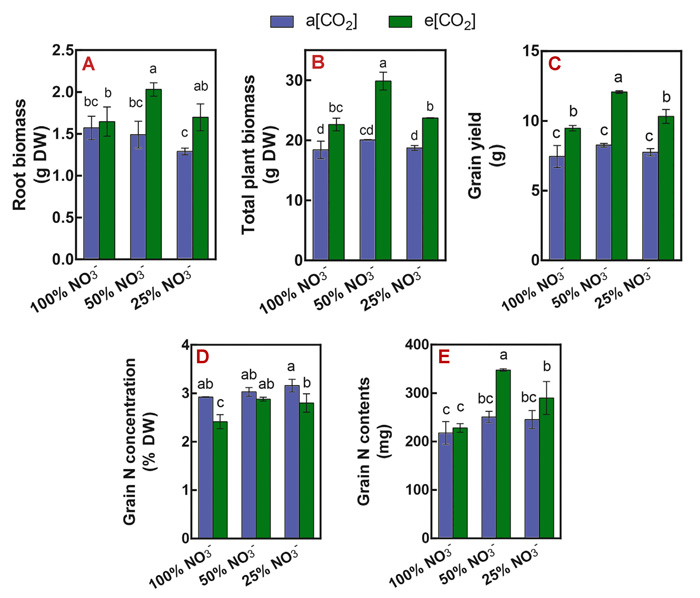| Follow @co2science |
Paper Reviewed
Fernando, N., Hirotsu, N., Panozzo, J., Tausz, M., Norton, R.M. and Seneweera, S. 2017. Lower grain nitrogen content of wheat at elevated CO2 can be improved through post-anthesis NH4+ supplement. Journal of Cereal Science 74: 79-85.
Nitrogen (N) is an essential nutrient required by plants for growth and is needed in large quantities. In many CO2 enrichment experiments, however, the biomass enhancements caused by elevated CO2 tend to be greater than the N uptake, which causes a decrease or dilution in the concentration of N in plant tissues. This dilution can also impact plant protein concentrations, which are affected by both plant N uptake and N remobilization efficiency. As a result, some have seized upon this occasionally observed outcome of N dilution protein decline (NDPD) as a perceived negative consequence of atmospheric CO2 enrichment on agriculture.
But is this really the case? Not according to new research by Fernando et al. (2017).
Working with the C3 cereal wheat (Triticum aestivum L. cv. H45) the team of six researchers investigated the impact of elevated CO2 and three different N treatments on grain N concentration, whole plant N uptake and N partitioning and remobilization during pre- and post-anthesis. The work was conducted in environmentally-controlled glasshouses in Horsham, Victoria, Australia during 2011. Glasshouse CO2 was maintained at either ambient (389 ppm) or enriched (700 ppm) for the duration of the study through harvest at 141 days after planting. N treatment was supplied in 3 forms (1) 100% NO3--N treatment, using KNO3, (2) 50% NO3--N and 50% NH4+-N, using NH4NO3 and (3) 25% NO3--N and 75% NH4+-N, using (NH4)2SO4 and KNO3. Although the forms of N used in each treatment differed, each treatment contained the same N concentration in the solution.
Results of the analysis are depicted in the figure below. Root biomass (panel A), total plant biomass (panel B) and grain yield (panel C) at harvest all increased in response to elevated CO2, regardless of the source of N supply; but the greatest response was observed in the 50% NO3--N and 50% NH4+-N supply treatment. In contrast, no significant differences in these three parameters were observed under ambient CO2 as a result of N supply treatment.
With respect to grain N concentration (panel D), despite the largest increase in biomass among the three N supply treatments, there was no significant difference between ambient and elevated CO2 treatments for wheat plants growing in the 50% NO3--N and 50% NH4+-N supply, whereas the N concentration declined at elevated CO2 under the other two N supply treatments. As a result, the grain N content (see panel E) in the 50% NO3--N and 50% NH4+-N supply treatment under elevated CO2 was approximately 40% greater than its ambient CO2 counterpart.
Such findings, in the words of Fernando et al., demonstrate that "when N is supplied as equal proportion of NO3- and NH4+ under elevated CO2 [NDPD] decline did not occur, while when N was supplied in 100% NO3- or as 25% NO3-, the decline was seen." And this finding led the researchers to conclude that "grain N concentration can be manipulated at elevated CO2 through changing the ratio of NO3- and NH4+ in the growth media," which observation, they add, strongly suggests that the sometimes-observed reductions of grain N and protein content in CO2 enrichment experiments are actually "independent of yield stimulation under elevated CO2."
Thus it is that another climate alarmist concern about rising atmospheric CO2 has crumbled under the weight of scientific investigation. A simple retooling of the way in which N is supplied to plants in CO2 enrichment studies can change the concentration of N observed in those plants from a marginal decline to a significant increase. And that is great news for those who have worried about the potential impacts of future protein declines on human nutrition, which they have anticipated will occur in the future due to rising atmospheric CO2.

Figure 1. Root biomass (A), total plant biomass (B), grain yield (C), grain N concentration (D) and grain N contents (E) of wheat grown under ambient (389 ppm, blue bars) and elevated (700 ppm, green bars) CO2 in 100% NO3--N treatment, 50% NO3--N treatment (50% NO3--N + 50% NH4+-N) and 25% NO3--N treatment (25% NO3--N + 75% NH4+-N) at maturity stage (141 DAP). Data are represented as mean ± standard deviation of 3 replicates. The same letters denote there are no significant differences according to Tukey's test (P < 0.05). Adapted from Fernando et al. (2017).




